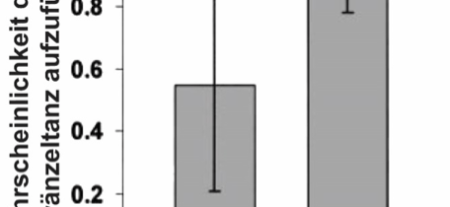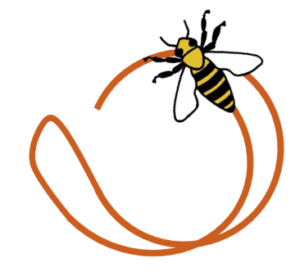A bee colony is a complex organism with a large number of tasks. To fulfill these optimally, the bees are in constant communication with each other. Their multifaceted language consists of dances, scents and noises. We have translated their language for you so you can understand the tittle-tattle of the bee colony.
[ApiGuide]
I am the Queen
The queen is letting her presence known by continuously releasing the so-called queen substance or «queen mandibular pheromone». This pheromone consist of 9 different substances. The pheromone is passed on to her retinue who distribute it to the rest of the hive. When the queen substance is absent, the workers will start rearing new queen larvae[1-2]. The queen substance therefore plays an important role in controlling the swarming process. It is assumed that in large colonies, the queen cannot produce enough of her pheromone to be distributed troughout the hive. This causes the workers which cannot sense the queen to start building queen cells, which in the end leads to swarming[2].
Also, the queen substance suppresses the ovarian development of the worker bees. In the presence of a queen only 0.01% of the workers lay eggs, whereas the proportion of egg laying workers in queenless colonies can be up to 25%[3].
Toot! Who else is here?
During the swarming process, the young queens make two different beeping sounds: tooting and quacking. After hatching, young queens begin with tooting, queens who have not yet hatched respond with quacks from the closed cells. Since bee colonies usually build a large number of swarm cells, each toot is followed by a choir of quacks. The function of these sounds is not yet fully understood. However, it is demonstrated that the tooting suppresses the hatching of other queens. In addition, it is assumed that hatched young queens get an impression of their competition based on the quacking sounds. In case of strong competition it might be wiser to leave the hive with a swarm instead of fighting the other queens[4].
Attack!
If there is any form of danger for the colony, the workers will release the alarm pheromone from their stingers. The pheromone consists of a complex mixture of over 20 fragrances, including isopentyl acetate, which is also present in the scent of bananas. The alarm pheromone calls other workers and signals the attack! So it might be wise to not eat your banana near an beehive [1].
Over here!
The Nasanov pheromone is released to attract other workers. It leads forager bees to the hive entrance, but is also released by forager bees to mark good sources of water and food. Further, it also plays an important role in ensuring the cohesion of the colony during swarming. The Nasanov pheromone consists of 7 substances and is released by the worker bees from the dorsal or upper part of their abdomen[1].
There’s something interesting over there
The Waggle dance is used by forager bees to inform their sisters about a good food sources. To let other bees know when the show begins, the dancer secretes a fragrance mixture at the beginning of her dance. The dance begins with the «waggle run», in which the dancer runs straight ahead, waiving her abdomen and flapping her wings. The direction of the waggle run indicates the direction of the food source in relation to the sun. The distance of the source is transmitted by the length of the waggle run and the quality of the place is shown by the number of laps the collector makes (Figure 1). Since it is pitch dark in the hive, the other bees have to «feel» the dance. So they follow the dancer at a 30° angle and touch her with their antennas (Figure 1)[5-6].

It appears that there are even regional dialects with the waggle dance; depending on the region, the distances of the waggle run varies. The emerging of these ‘dialects’ are believed to be the result as an adaptation to different geographical conditions. For instance, In small-scale, strongly structured landscapes, it might be useful to code distances in longer waggle runs to capture all the details of the flight. In large-scale areas with longer flight distances, the route description might not have to be that elaborate. The longer the waggle run for certain distances, the more accurate the route description. At the same time, however, the dancer’s has to spend more time and energy[6]
There’s something just around the corner
If there is a food source in the immediate vicinity of the hive, foragers will perform the «round dance». The bee will run in circles and make high squeaking sounds. In contrast to the waggle dance, the round dance contains hardly any information about the location of the food source. As a reaction to the round dance, other workers begin to search the surroundings of the hive[5-6].

The impatient girls
The trembling dance is used by foragers when waiting times occur during the unloading of nectar and pollen. The bees will start walking around on the combs, twitch their bodies and flap their wings. As a reaction to the trembling dance, other bees in the hive leave their work and rush over to collect their load[6].
Here we go
The vibration signal or «dorso-ventral abdominal vibration (DVAV) signal», generally serves to increase the activity of the colony. A bee will hold onto the comb with her back legs and to another bee with her middle and front legs. She will then shake her abdomen rapidly for about 1-2 seconds and create a vibration which can be felt throughout the colony. It is used in various situations, for example when an increase is needed in the colony’s collection activities (the collection, unloading and storage of food by the hive bees and the communication of food sources through dances). The vibration signal is used more often in the mornings, and can be understood as a wake-up call to the workers.
Furthermore, the vibration signal has an important function during the swarming process. It is assumed that it serves to coordinate the rearing of young queens and incites the old queen to swarm. In the 3-4 weeks before swarming, the old queen receives numerous vibration signals which prevent her from attacking swarm cells. On top of that, the signal causes the queen to move more which means she loses weight, helping her to prepare for the flight. Moreover, the vibration signal allows the workers to influence the choice of the new queen. After the young queens hatch, they receive more vibrations from the workers. Queens who receive the signal more often will eliminate more rivals and have an increased probability of ascending to the throne[7].
Departure
Coordinating thousands of bees in a swarm is not an easy task! Bees use two signals to indicate when they are leaving the hive: they squeak and perform the whir dance. The squeaking starts more than an hour before the take-off and prompts the bees to warm up their wing muscles. The whir dance on the other hand, starts right before leaving the hive and is the signal for departure[8]. Thereby the bees run in a zigzag pattern and flap their wings. These two signals also coordinate the swarm’s departure from their assembly point to their new nest[9].
I need a cleaning
If honeybees are covered with dust which they cannot remove themselves, they ask their hive mates for help with the so-called cleaning dance. The dancer shakes her abdomen back and forth at a certain frequency, whereupon the other workers hurry to clean her up. In order to be brushed properly, the dancer stands still during the cleaning and spreads her wings[10].
Take care of me
Already in the brood-stage, the bees begin to communicate. The bee larvae give off the so-called brood recognition pheromone – a mixture of 10 fragrances. Its composition changes with the age of the larvae and gives the nurse bees information about the needs of the brood. The brood pheromone controls both the nutrition of the larvae (royal jelly or pollen bread) and the capping of the cells on the ninth day[1-2].
All clear?
We hope you enjoyed our bee-language course and that it will make it easier for you to communicate with your bees. Admittedly, they are not that easy to understand and a large part of their complex language remains a mystery to us. But sometimes we can witness bee dances, their squeaking or their usage of particular pheromones. Unfortunately, they often do not let us join their conversations easily.
Literature
1 Slessor, K. N., Winston, M. L. & Le Conte, Y. Pheromone communication in the honeybee (Apis mellifera L.). Journal of Chemical Ecology 31, 2731-2745, doi:10.1007/s10886-005-7623-9 (2005).
2 Trhlin, M. & Rajchard, J. Chemical communication in the honeybee (Apis mellifera L.): a review. Veterinarni Medicina 56, 265-273 (2011).
3 Page, R. E. & Erickson, E. H. Reproduction by worker honey bees (Apis mellifera) Behavioral Ecology and Sociobiology 23, 117-126, doi:10.1007/bf00299895 (1988).
4 Drosopoulos, S. & Claridge, M. F. Insect Sounds and Communication: Physiology, Behaviour, Ecology, and Evolution. CRC Press, 421-436.
5 Vonfrisch, K. Orientierungsvermögen und Sprache der Bienen Naturwissenschaften 38, 105-112 (1951).
6 Dyer, F. C. The biology of the dance language. Annual Review of Entomology 47, 917-949, doi:10.1146/annurev.ento.47.091201.145306 (2002).
7 Schneider, S. S. & Lewis, L. A. The vibration signal, modulatory communication and the organization of labor in honey bees, Apis mellifera. Apidologie 35, 117-131, doi:10.1051/apido:2004006 (2004).
8 Rangel, J. & Seeley, T. D. The signals initiating the mass exodus of a honeybee swarm from its nest. Animal Behaviour 76, 1943-1952, doi:10.1016/j.anbehav.2008.09.004 (2008).
9 Rittschof, C. C. & Seeley, T. D. The buzz-run: how honeybees signal ‚Time to go!‘. Animal Behaviour 75, 189-197, doi:10.1016/j.anbehav.2007.04.026 (2008).
10 Land, B. B. & Seeley, T. D. The grooming invitation dance of the honey bee. Ethology 110, 1-10, doi:10.1046/j.1439-0310.2003.00947.x (2004).